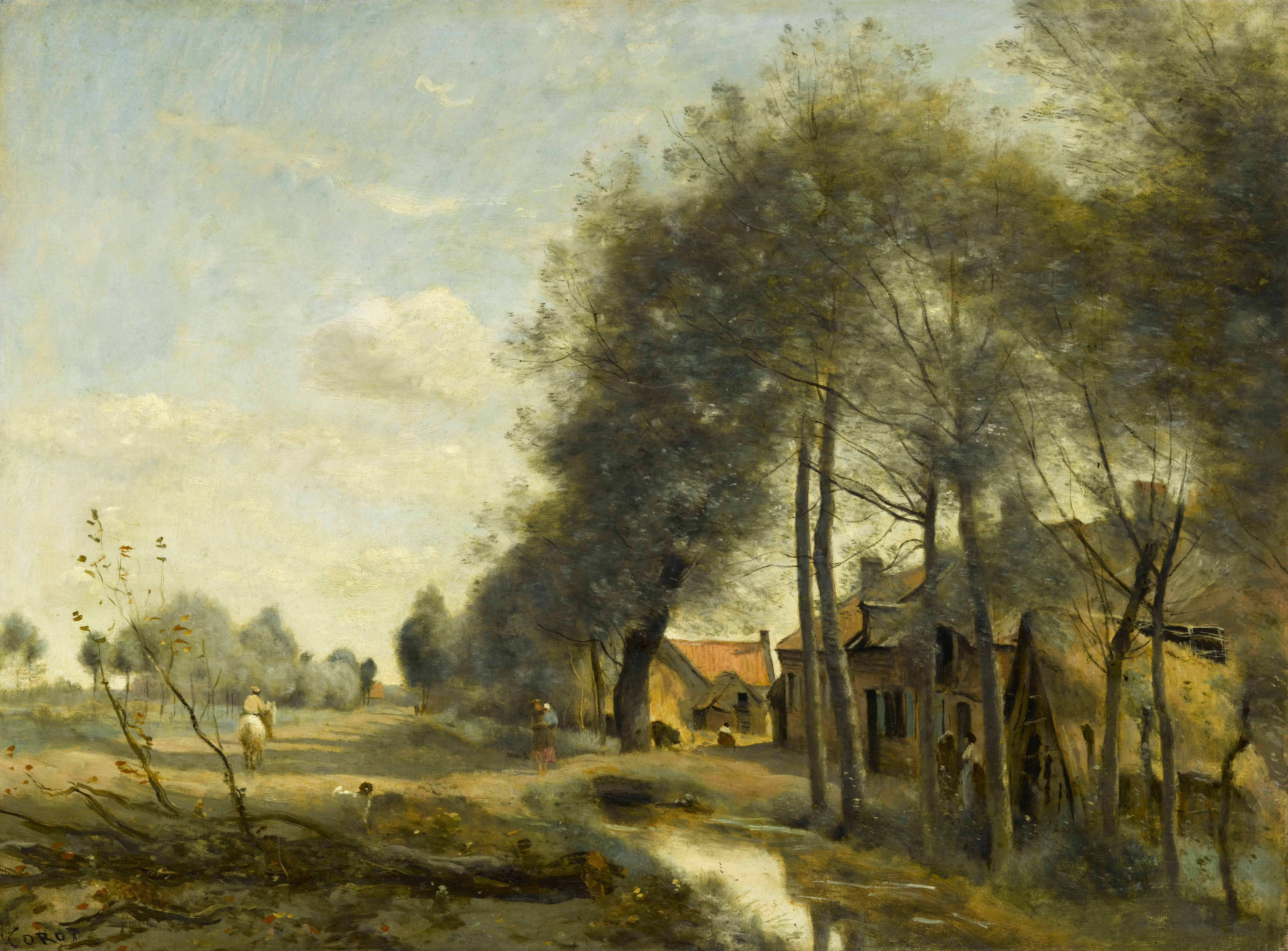Jean-Baptiste Camille Corot
Sin, près Douai. La Route de Waziers, 1874

A year before his death, Camille Corot painted a country road near the village of Sin-le-Noble, south-east of Douai, and brought it to life by adding rustic staffage. The long line of trees on the left, fronted by a ditch, draw our gaze into the far distance, while two spindly, bare tree trunks in the foreground afford us a glimpse of the thatched houses beyond. Captured in delicate brushstrokes on the opposite side of the road is a row of much younger trees. According to Alfred Robaut,1 Corot’s friend and the author of his first catalogue raisonné, this scene executed in loose brushstrokes and a silvery palette was painted en plein air between 8 and 11 in the morning in July 1874.2 The hand of the 77-year-old painter bespeaks great self-assurance and there is no sign at all of any loss of creative vigour. The sunlight streaming in through the trees on the left makes for a pleasing play of light and shade on the road and tells us that the painter was looking south. It follows that while working on this canvas, he had the village of Waziers at his back. Corot first explored this corner of north-eastern France in 1851, when he went to Arras to visit his artist friend Constant Dutilleux,3 a native of Douai. In the years thereafter he made regular trips to the region,4 and, almost exactly a year prior to the painting of our work, painted a similar, or perhaps even the same, road near Sin-le-Noble (fig. 1). Robaut, who was living with the artist during this period, later described the scene to Moreau-Nélaton:5
“He selected a subject from the outskirts of the town in the village of Sin-le-Noble (…) Four or five cottages with red roofs along a grassy road from which they were separated by a thin line of trees, and, above, some clouds joining their light wisps to the blue canopy: for Corot, that’s the material for a masterpiece. This ordinary landscape is a poem of light and air.”6
Robaut’s unique importance in relation to Corot rests on his compilation of the first catalogue raisonné, published in 1905, and on his role as a major collector of Corot. The painting under discussion here belonged to his collection of more than 250 works by the artist. As a glance at the provenance shows, another important collector of Corot from this period was also able to call the painting his own for a while; this was the dentist Dr. Verdier, who is known to have had at least thirty-nine paintings by the artist in his possession. And after its sojourn with Dr. Verdier, our painting entered yet another important contemporary collection, that of the industrialist John Saulnier of Bordeaux, whose obsession with the painter’s landscapes had prompted him to assemble twenty-seven of his works.7 The interest of this exclusive circle of collectors in Corot also reflects the depth and breadth of his influence on the development of landscape painting during this period. Even while learning his craft under Michallon and Bertin,8 Corot frequently ventured out into the environs of Paris to study nature at first hand, and in 1822 he is known to have visited Fontainbleau for this purpose. When the works that he submitted to the Paris Salon from his first visit to Italy in 1827 met with success he became a regular contributor to that annual event.9 His nature studies, in particular, were highly prized as models by both the younger artists of the Barbizon School and the Impressionists, whom he would later support in his role as juror of the Paris Salon. Significantly, our painting was painted in 1874, the year of their first exhibition.
 Fig. 1 Jean-Baptiste Camille Corot, La route de Sin-le-Noble, près de Douai, 1873, 60 x 81 cm, Paris, Musée du Louvre, inv. no. R.F. 1359, bpk | GrandPalaisRmn | Gérard Blot
Fig. 1 Jean-Baptiste Camille Corot, La route de Sin-le-Noble, près de Douai, 1873, 60 x 81 cm, Paris, Musée du Louvre, inv. no. R.F. 1359, bpk | GrandPalaisRmn | Gérard Blot
Footnotes
-
Besides being active as both a lithographer and a photographer, Alfred Ernest Robaut (1830–1909) is known mainly for having compiled the first catalogues raisonnés of Eugène Delacroix (1798–1863) and Jean-Baptiste Camille Corot. ↩
-
Alfred Robaut, L´Œuvre de Corot. Catalogue raisonné et illustré, vol. 3, Paris 1905, p. 314. ↩
-
Constant Dutilleux (1807–1865) was a French landscape painter. ↩
-
Corot, exh. cat. Metropolitan Museum of Art, New York 1996, p. 401. ↩
-
Adolphe Étienne Auguste Moreau-Nélaton (1859–1927) was a French painter, art historian and collector. ↩
-
Étienne Moreau-Nélaton, “La vue de Sin-le-Noble, près Douai, par Corot,” in the Gazette des beaux-arts (1903), p. 491. ↩
-
Corot, exh. cat. Metropolitan Museum of Art, New York 1996, p. 399. ↩
-
Jean-Victor Bertin (1767–1842) and Achille-Etna Michallon (1796–1822) were important landscape painters in their day. The latter won the 1817 Grand Prix de Rome for historic landscapes. ↩
-
Corot, exh. cat. Metropolitan Museum of Art, New York 1996, p. 413. ↩